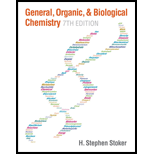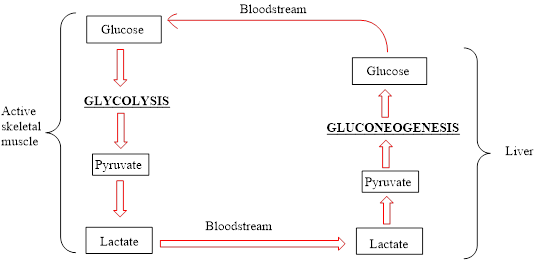
Concept explainers
Interpretation: To write an equation for the conversion of pyruvate to lactate in the Cori cycle that includes the structures of lactate and pyruvate.
Concept introduction: Glucose is converted to pyruvate by glycolysis
The Cori cycle is named after its discoverers, Gerty Radnitz Cori, and Carl Cori.
An overview of the Cori cycle is as follows:

Want to see the full answer?
Check out a sample textbook solution
Chapter 24 Solutions
GENERAL,ORGANIC,+BIO.CHEM.-MINDTAP
- How many molecules of ATP are obtained from the NADH and FADH2 formed in the beta-oxidation of one molecule of a 16-carbon saturated fatty acyl-CoAarrow_forwardThe catabolism of several amino acids generates succinyl-CoA. Describe the series of reactions that are required to convert mitochondrial succinyl-CoA to cytosolic oxaloacetate that can be used for gluconeogenesis.arrow_forwardFatty acids and triglycerides are an important source of nutrition and a dense form of stored energy. Digestion of fats yields more energy per gram than digestion of carbohydrates. Each turn on the B-oxidation spiral results in the formation of a new acetyl COA molecule. This molecule can then be used to generate more energy in A) fatty acid synthesis B) ketolysis C) glycolysis D) tricarboxylic acid cycle E) oxidative phosphorylationarrow_forward
- Pyruvate must be oxidized into acetyl-CoA in order to enter the citric acid cycle. Which of the following are required for this process per one molecule of pyruvate? ADP, FADH ATP, NADH ATP, NAD+ NAD+, coenzyme A CO2, NADHarrow_forwardDetermine the number of ATP molecules that can be formed from the complete oxidation of 10 molecules of acetyl CoA. The overall net equation for the complete oxidation of acetyl CoA is provided below. Acetyl CoA + 3NAD+ + FAD + GDP + Pi + 2H₂O → 2CO2 + HS-CoA + 3NADH + 3H+ + FADH2 + GTP (Given: The oxidation of one NADH yields 2.5 ATP; the oxidation of one FADH2 yields 1.5 ATP; and one GDP yields 1 ATP.) O 10 ATP O 7,5 ATP O 100 ATP O 75 ATParrow_forwardDuring the overall process of glycolysis, in which of the following occurs for each glucose molecule processed. net loss of two ATP molecules net loss of four ATP molecules net gain of two ATP molecules net gain of four ATP moleculesarrow_forward
- Most fatty acids have an even number of carbons and, therefore, are completely metabolized to acetyl-CoA. A fatty acid with an odd number of carbons is metabolized to acetyl-CoA and one equivalent of propionyl-CoA. The following two reactions convert propionyl-CoA into succinyl-CoA, a citric acid cycle intermediate, so it can be further metabolized. Each of the reactions requires a coenzyme. Identify the coenzyme for each step. From what vitamins are the coenzymes derived?arrow_forwardMost fatty acids have an even number of carbons and, therefore, are completely metabolized to acetyl-CoA. A fatty acid with an odd number of carbons is metabolized to acetyl-CoA and one equivalent of propionyl-CoA. The following two reactions convert propionyl-CoA into succinyl-CoA, a citric acid cycle intermediate, so it can be further metabolized. Each of the reactions requires a coenzyme. Identify the coenzyme for each step. From what vitamins are the coenzymes derived?arrow_forwardWhy is oxidation important during the citric acid cycle? O The oxidation allows for isomerization The oxidation attaches acetyl coa to oxaloacetate O The oxidation produces CO2 The oxidation of a molecule in the citric acid cycle produces NADH or FADH2arrow_forward
- One of the steps that occur during the synthesis of ketone bodies is shown below. OH D-beta-hydroxybutyrate Dehydrógenase .coo coo0 H3C cooo Нас acetoacetate D-beta-hydroxybutyrate Does this process require FAD or NAD*, FADH2 or NADH as the reactant coenzyme? Explain your answer in a few words.arrow_forwardThe glycolysis pathway is shown. Place the enzymes used in each of the ten labeled steps of the pathway. Be sure to scroll down completely until pyruvate is formed. glucose-6-phosphate fructose-6-phosphate fructose-1,6-biphosphate ADP ATP ADP ATP glucose dihydroxyacetonephosphate glyceraldehyde-3-phosphate 1,3-bisphosphoglycerate ADP ATP 3-phosphoglycerate 2-phosphoglycerate phosphoenolpyruvate ADP ATP pyruvate Answer Bank phosphoglycerate mutase hexokinase phosphohexose isomerase triosephosphate isomerase phosphofructokinase-1 pyruvate kinase phosphoglycerate kinase aldolase enolase glyceraldehyde-3-phosphate dehydrogenase NAD + HOPO3²- NADH+H*arrow_forwardWhy must the NADH produced in glycolysis be re-oxidized to NAD +? How is this accomplished aerobically? How is this accomplished anaerobically?arrow_forward
 General, Organic, and Biological ChemistryChemistryISBN:9781285853918Author:H. Stephen StokerPublisher:Cengage Learning
General, Organic, and Biological ChemistryChemistryISBN:9781285853918Author:H. Stephen StokerPublisher:Cengage Learning Organic And Biological ChemistryChemistryISBN:9781305081079Author:STOKER, H. Stephen (howard Stephen)Publisher:Cengage Learning,
Organic And Biological ChemistryChemistryISBN:9781305081079Author:STOKER, H. Stephen (howard Stephen)Publisher:Cengage Learning, Chemistry for Today: General, Organic, and Bioche...ChemistryISBN:9781305960060Author:Spencer L. Seager, Michael R. Slabaugh, Maren S. HansenPublisher:Cengage Learning
Chemistry for Today: General, Organic, and Bioche...ChemistryISBN:9781305960060Author:Spencer L. Seager, Michael R. Slabaugh, Maren S. HansenPublisher:Cengage Learning



